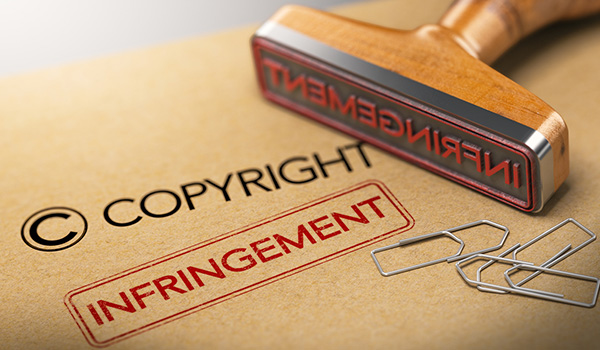01-10-2023 |
Don't Be in the Wrong: How to Avoid Copyright Infringement
By: Jordan Meggison-Decker

If you have ever been on either the sending or receiving end of a Cease-and-Desist Letter or a Copyright Infringement Notice, you know that it is not a pleasant feeling in either instance. Copyright issues pop up every day in our Internet driven lives and knowing the copyright basics can ensure that you stay on the right side of the law when building content of your own.
Let’s start by explaining copyright infringement through defining a few basic terms. Copyright is the category of intellectual property that protects original works of authorship after the author fixes the work to a tangible medium. Copyrighted works can be anything from paintings and photographs to musical compositions and computer programs. To be considered ‘original,’ works of authorship must possess a minimal amount of creativity and they must be independently created by a human author. To be considered ‘fixed,’ a work must be captured in a sufficiently permanent medium (i.e., written down or recorded).
A second important aspect of copyright law is how copyright protection arises. Registration of the original work of authorship is not required in order to receive the benefits of copyright protection, however, registration is required in order to bring suit against a copyright infringer. As soon as an original work is created and fixed in a tangible medium, the creator is the author and owner of a copyrighted work. Companies and organizations can also be copyright owners. Under the “work made for hire” doctrine in copyright law, works created by employees within the scope of their employment are owned by the employer. As with patents and trademarks, copyright ownership can also arise from contractual agreements such as assignment agreements, wills, or bequests. Copyright protection will last during the author’s life and for 70 years after for most copyrighted works, with protection of works made for hire lasting either 95 years from publication or 120 years from creation, whichever is shorter.
Copyright infringement occurs when a copyrighted work is used, reproduced, publicly displayed, or distributed without permission of the copyright owner. Certainly, each and every one of us are daily copyright users. Reading newspaper articles, watching movies, listening to music, and many other daily activities place all of us in the position of a copyright user. However, most of these uses are paid for (and therefore constitute use with permission) through subscriptions, through purchasing tickets at a movie theatre, through buying songs or CDs, etc., or the copyrighted work is in the public domain, ensuring that everyone can have access to it. Copyright infringement becomes an issue when another’s work is taken and distributed, copied, modified, performed, or displayed without permission. The most common forms of copyright infringement are image and text infringement. The Internet and the massive amounts of content shared via the Internet every day exacerbate infringement issues. Any instance of taking an image from the Internet and distributing it on a website, newsletter, or blog could constitute actionable copyright infringement. The same goes for text taken from another’s website, blog, news article, etc.
There are several ways that you can avoid accidental copyright infringement:
- If you did not create the original work of authorship, you can choose not to use it under any circumstances.
- Understand that works found on the Internet are generally not fair game to incorporate into your own content. Note, this is true whether you benefit financially from the use of the content or not.
- Obtain express permission from the author of the work before incorporating the work into your content. This permission can take the form of a licensing agreement or can be a simple written acknowledgment from the author of your right to use the work.
Why is it important to avoid accidental copyright infringement?
- Civil penalties for willful infringement can be as high as $150,000 per instance of work
- Statutory damages can range from $750 and $30,000 per instance of work
- Criminal penalties can range up to $250,000 in fines and result in up to five years in jail
Copyright is an important and often overlooked portion of intellectual property law. By considering what material is subject to copyright protection, obtaining permission to use protected material, and contacting an attorney about implicated legal rights, many issues can be prevented. If you have any questions regarding your intellectual property rights, please reach out to our Intellectual Property team at BrownWinick. We are here to offer trusted legal advice and add value to any matter, including those with complex and novel issues.
Meet the Author:

